Molecular Docking and MD Simulations Reveal D-PL Binding Mode and Conformational Changes in D-Lac
Subsequent molecular docking studies, involving the insertion of D-PL into the predicted structure of D-Lac, elucidated a pre-reactive binding mode (Figure 1F). This analysis identified two potential conformations, designated as Config1 and Config2, which differ in the orientation of the hydroxyl group of D-PL. Config1 points towards H79, while Config2 points towards Y215. Independent molecular dynamics (MD) simulations were conducted for each D-PL conformation. The binding free energy, calculated using MM/GBSA, indicated that Config2 was not the most energetically favorable conformation for D-PL binding within the D-Lac active site. Config1 exhibited a slightly lower binding free energy compared to Config2, approximately 1.32 kcal/mol (Table S1). Consequently, Config1 was designated as the reaction conformation of D-PL interacting with D-Lac. Notably, the binding of D-PL to D-Lac was accompanied by an 'open-close' conformational change in the cap structure domain of D-Lac (Figure 1G). The cap-open conformation allows the active site to interact with the solvent, thereby facilitating substrate binding and product release. Conversely, the cap-closed conformation promotes a nucleophilic attack, driving the catalytic reaction.

原文地址: https://www.cveoy.top/t/topic/j999 著作权归作者所有。请勿转载和采集!